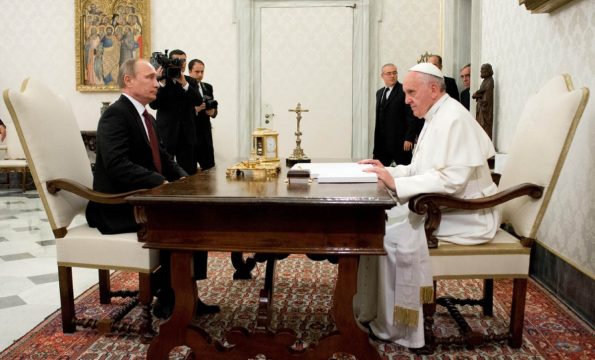The Trumpet: El presidente ruso Vladimir Putin, se reunió con el Papa Francisco en el Vaticano el 4 de julio. Esta es su tercera reunión con el Papa, un número elevado para un dictador que está estrechamente aliado con la Iglesia Ortodoxa, que se separó del papado hace casi 1.000 años.
La reunión fue privada y se sabe poco sobre lo que se habló. Pero se esperaba que la situación en Ucrania ocupara un lugar destacado en la agenda. Una declaración emitida por el Vaticano dijo que debatieron la situación en Siria, Ucrania y Venezuela, así como «la vida de la Iglesia Católica en Rusia.»
Putin calificó la charla de casi una hora como «muy sustantiva.»
Después de la reunión, Putin se reunió con el presidente y primer ministro de Italia. Mientras hablaba con el primer ministro Giuseppe Conte, Putin pidió ayuda para mejorar las relaciones entre Rusia y la Unión Europea. En particular pidió el fin de las sanciones de la UE y los Estados Unidos que le han costado a su país U$ 50 mil millones desde 2014. Sin embargo, Putin afirma que la UE ha sufrido aún más con un acceso limitado al mercado ruso. Conte ofreció su apoyo para mejorar las relaciones entre Rusia y la UE.
Esta relación política y religiosa entre Rusia y Europa ha mejorado durante varios años.
En febrero de 2016 el Papa Francisco se reunió con el Patriarca Kirill, líder de la Iglesia Ortodoxa Rusa. Esta fue la primera vez que los líderes de estas dos iglesias se habían reunido desde el Gran Cisma de 1054.
Muchos consideran que la Iglesia Ortodoxa Rusa es esencialmente una herramienta del gobierno. Hay evidencia no confirmada de que Kirill es un ex agente de la KGB y evidencia definitiva de que muchos líderes de la iglesia eran agentes de la KGB.
Putin, un ex agente de la KGB, ha utilizado la Iglesia Ortodoxa Rusa como una herramienta política para reunir a los rusos en torno a su visión de su país. Y ahora Putin parece estar poniendo a la Iglesia Católica de su lado. Esta relación de acercamiento comenzó a aparecer cuando Putin conoció al Papa Francisco en noviembre de 2013. El mismo mes, Ucrania suspendió inesperadamente los preparativos para unirse a la UE. Luego vino marzo de 2014: Rusia invadió Ucrania y el Vaticano permaneció en silencio. En febrero de 2015, el Papa condenó la «violencia fratricida», lo que implica que Ucrania estaba en medio de una guerra civil, en lugar de identificar la invasión extranjera. En junio de 2015, Putin se reunió con Francisco por segunda vez.
El periódico The Trumpet siempre ha esperado que Rusia y una Europa liderada por Alemania hagan algún tipo de acuerdo. El Vaticano que a menudo desempeña un papel político muy público, podría ser una gran parte de hacer que esto suceda.
La historia nos advierte exactamente qué esperar de un acuerdo entre Alemania y Rusia.
En el período previo a la Segunda Guerra Mundial, tanto Rusia como Alemania tuvieron crecientes sueños imperialistas. La cooperación secreta bajo el Tratado de Rapallo de 1922 les permitió usar la experiencia de cada uno para avanzar militarmente y sin temor a ser apuñalado por la espalda. Entonces, cuando los líderes de Alemania y Rusia se unieron en 1939 para firmar el Pacto Molotov-Ribbentrop, los dos ya eran viejos amigos. Este «pacto de no agresión» dividió a Europa del Este entre Rusia y Alemania y logró el apoyo mundial comunista al régimen nazi. Eso fue hasta que Hitler se volvió contra los rusos en 1941.
Este breve fragmento de la historia revela la naturaleza de siglos de relaciones ruso-alemanas. Cambian rápidamente de mejores amigos a peores enemigos.
Vemos que el mismo patrón se repite hoy. Europa, con Alemania y el Vaticano a la cabeza, está colaborando cada vez más con Rusia: invitándolo de nuevo al Consejo de Derechos Humanos de Europa, construyendo el gasoducto Nord Stream 2 y manteniendo conversaciones con el primer ministro italiano sobre el fomento de las relaciones de Rusia con la UE, por ejemplo.
Europa y Rusia tienen varios intereses que se cruzan y tienen el potencial de causar mucha fricción: combustible, una frontera común en Europa del Este, etc. Necesitan un acuerdo para evitar las amenazas del otro. El Vaticano podría estar ayudando a que esto suceda.
Conexión Profética:
“Vi una de sus cabezas como herida de muerte, pero su herida mortal fue sanada; y se maravilló toda la tierra en pos de la bestia,” Apocalipsis 13:3.






Comments